HOW LIBERTARIANS DESCRIBE HOUSTON, PLAYING THE NEW YORK CARD, AND THE SUE ELLEN MISCHKE OF METROPOLISES 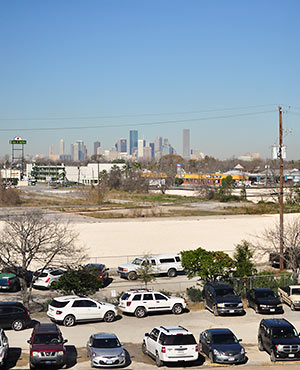 Cort McMurray stuffs more colorful Houston-in-a-phrase quips into his latest in-search-of-the-city essay than will fit in this little lookie-here linkpost, but a few are worth drawing out: “There is a wide difference of opinion on whether [Houston’s] messiness is a good thing. Some of us find it distressing. Tory Gattis and the other evangelists of ‘Opportunity Urbanism’ disagree, painting Houston as a sort of libertarian paradise, a place where fully actualized men and woman can work out their destinies through grit, brains, and good ol’ trial and error. Master plan? We don’t need no stinking master plan.
Surveys indicate that the majority of Houstonians are quite content to live in this Sue Ellen Mischke of metropolises: we love ‘the whole free-swinging, freewheeling attitude’ of the place, a city that offers us the strange comfort of knowing that no matter our neighborhood, we’re never more than 37 seconds away from a gas station, a Taco Bell, or an all-night tattoo parlor.
Eventually, all the world will be Houston, endless rings of toll roads forming concentric circles around some increasingly distant downtown, endless vistas of cars and Costcos and ‘lifestyle environments,’ worlds without end. This sprawl is ‘vibrant,’ and suburban ‘opportunity zones’ (opportunity is a key word for these people) are the inevitable result of vibrant, opportunistic people searching for better schools, better shopping environments, and better quality of life. In the Opportunity Urbanists’ perfect world, the Houston exurbs would stretch from the Sabine River to somewhere around Fort Stockton, and any suggestion otherwise amounts to a betrayal, a ‘de-Houstonizing’ of Our Fair City.” Another, more realist vision of Houston from McMurray’s grab bag: a spread-out, risk-graded, need-more-freeways array of poors-filled “gray zones” and haves-filled “safe zones.” [Houstonia] Photo: Candace Garcia
Cort McMurray stuffs more colorful Houston-in-a-phrase quips into his latest in-search-of-the-city essay than will fit in this little lookie-here linkpost, but a few are worth drawing out: “There is a wide difference of opinion on whether [Houston’s] messiness is a good thing. Some of us find it distressing. Tory Gattis and the other evangelists of ‘Opportunity Urbanism’ disagree, painting Houston as a sort of libertarian paradise, a place where fully actualized men and woman can work out their destinies through grit, brains, and good ol’ trial and error. Master plan? We don’t need no stinking master plan.
Surveys indicate that the majority of Houstonians are quite content to live in this Sue Ellen Mischke of metropolises: we love ‘the whole free-swinging, freewheeling attitude’ of the place, a city that offers us the strange comfort of knowing that no matter our neighborhood, we’re never more than 37 seconds away from a gas station, a Taco Bell, or an all-night tattoo parlor.
Eventually, all the world will be Houston, endless rings of toll roads forming concentric circles around some increasingly distant downtown, endless vistas of cars and Costcos and ‘lifestyle environments,’ worlds without end. This sprawl is ‘vibrant,’ and suburban ‘opportunity zones’ (opportunity is a key word for these people) are the inevitable result of vibrant, opportunistic people searching for better schools, better shopping environments, and better quality of life. In the Opportunity Urbanists’ perfect world, the Houston exurbs would stretch from the Sabine River to somewhere around Fort Stockton, and any suggestion otherwise amounts to a betrayal, a ‘de-Houstonizing’ of Our Fair City.” Another, more realist vision of Houston from McMurray’s grab bag: a spread-out, risk-graded, need-more-freeways array of poors-filled “gray zones” and haves-filled “safe zones.” [Houstonia] Photo: Candace Garcia
Sprawl
CALL HOUSTON A METROPOLIS INSIDE THE LOOP, BUT IT’S A MEGALOPOLIS BEYOND 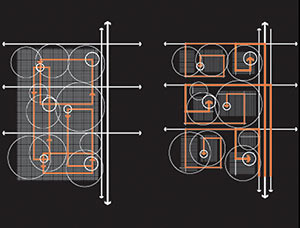 “In the 1950s just about the entire world abandoned continuous block and street urbanism and switched over to spine-based urbanism. We moved from a metropolitan to a megalopolitan type of urbanism and to really get that you have to know the distinction between the two terms. On some level, we all know that when we go outside the Loop that we have moved into a different world, a different reality. The way we navigate outside the Loop is totally different from the way we navigate inside the Loop. Our relationship to nature is different, and our relationship to built form completely changes. We need to be more precise with language in order to appreciate these differences.” — Rice architecture prof Albert Pope, in the latest issue of Cite magazine. [OffCite] Diagram of traffic patterns in grid (left) and spine systems (right): Albert Pope
“In the 1950s just about the entire world abandoned continuous block and street urbanism and switched over to spine-based urbanism. We moved from a metropolitan to a megalopolitan type of urbanism and to really get that you have to know the distinction between the two terms. On some level, we all know that when we go outside the Loop that we have moved into a different world, a different reality. The way we navigate outside the Loop is totally different from the way we navigate inside the Loop. Our relationship to nature is different, and our relationship to built form completely changes. We need to be more precise with language in order to appreciate these differences.” — Rice architecture prof Albert Pope, in the latest issue of Cite magazine. [OffCite] Diagram of traffic patterns in grid (left) and spine systems (right): Albert Pope
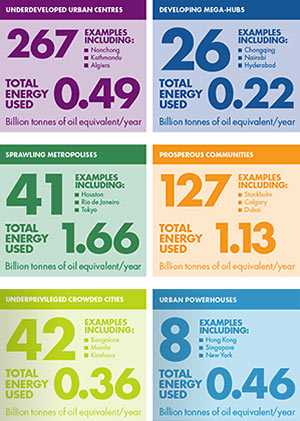 The folks at Shell may not have known a new campaign was about to kick off declaring Houston to be “The City of No Limits,” but a new report from the oil company on the future of cities around the world certainly helps reinforce a just-as-proud image of our 8,778-square-mile Texas spread. “New Lenses on Future Cities,” one of a series of just-released “scenario” studies sponsored by Shell in conjunction with The Centre for Liveable Cities in Singapore, classifies urban areas around the world into 6 distinct categories based on common features.
The folks at Shell may not have known a new campaign was about to kick off declaring Houston to be “The City of No Limits,” but a new report from the oil company on the future of cities around the world certainly helps reinforce a just-as-proud image of our 8,778-square-mile Texas spread. “New Lenses on Future Cities,” one of a series of just-released “scenario” studies sponsored by Shell in conjunction with The Centre for Liveable Cities in Singapore, classifies urban areas around the world into 6 distinct categories based on common features.
Houston, according to the researchers, is too large to be considered one of the Prosperous Communities, and hasn’t earned its way into the Developing Mega-Hubs or Urban Powerhouses clubs. (It certainly doesn’t qualify as an Underprivileged Crowded City or Underdeveloped Urban Centre either) Instead, the report says Houston is a seminal example of a Sprawling Metropolis, proudly featuring it on some accompanying infographics illustrating the archetype (see the green square above). (Other members of this distinctive group of 41 cities include Rio de Janeiro, Tokyo, and Los Angeles.)
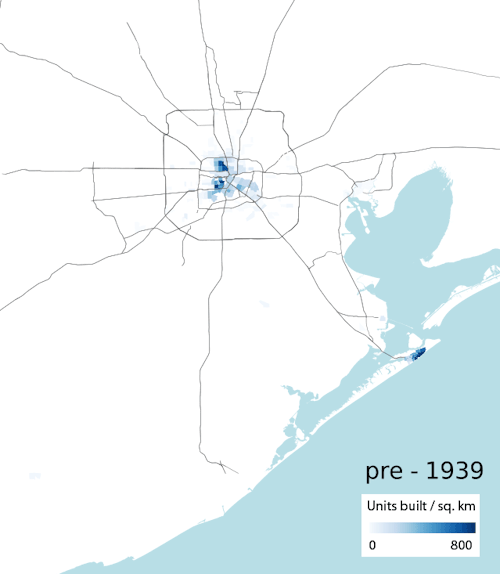
If the Greater Houston Partnership is eager to include some exhibits or animated GIFs to go along with the video footage of cars driving through imaginary barriers, shiny skyscrapers, and smiling people that pepper its new campaign celebrating Houston as The City of No Limits, it might want to look at the work of California computational biologist [and former Houstonian and longtime Swamplot reader] Ian Rees. Using data from the American Community Survey, Rees mapped structures in the region by the decade they were built, grading their concentration with varying shades of blue.  The result helps us visualize the decades-long march of Houston housing ever outward. His map, shown above, was featured in a series of articles on the Next City website on urban sprawl, a few of which compare Houston’s growth to those of other major U.S. cities.
Unfortunately, the data (and the dancing blue construction hotspots) stop in 2010, and we’re left to ourselves to wonder whether Houston is still on track to continue its now-officially-enshrined core mission. An earlier version of Rees’s map breaks out the last recent decade into 2 separate frames, helping to illustrate the scale and sequence of the more recent Inner Loop construction revival:
COMMENT OF THE DAY: THEY ONLY CALL HOUSTON SPRAWLING BECAUSE THERE’S NOT A WHOLE LOT ELSE TO NOTICE — YET  “Sorry, but Houston is no more sprawled than any other large metros. Look at aerial imagery of any of the big ones. Just because Atlanta, Dallas, Phoenix, LA, Chicago, etc. all have organized sprawl (zoning), doesn’t mean it’s any better than our non-zoned city sprawl. My point: sprawl is sprawl. I think cities like Houston get called out more when it comes to sprawl because of our lack of density in our core. As the inner loop core keeps densifying and gains a more wide spread identity, I think the sprawl argument against Houston will level out. . . .” [Ed, commenting on New ‘City with No Limits’ Slogan Will Be a Catchy, Fun Way To Promote Houston’s Legendary Sprawl] Illustration: Lulu
“Sorry, but Houston is no more sprawled than any other large metros. Look at aerial imagery of any of the big ones. Just because Atlanta, Dallas, Phoenix, LA, Chicago, etc. all have organized sprawl (zoning), doesn’t mean it’s any better than our non-zoned city sprawl. My point: sprawl is sprawl. I think cities like Houston get called out more when it comes to sprawl because of our lack of density in our core. As the inner loop core keeps densifying and gains a more wide spread identity, I think the sprawl argument against Houston will level out. . . .” [Ed, commenting on New ‘City with No Limits’ Slogan Will Be a Catchy, Fun Way To Promote Houston’s Legendary Sprawl] Illustration: Lulu
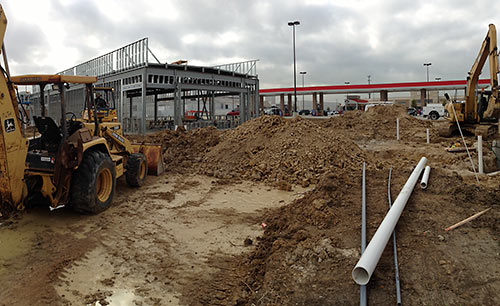
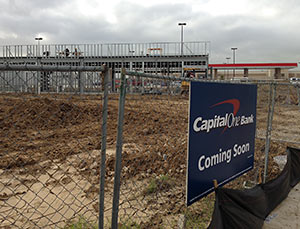 Reader Debnil Chowdhury sends in these pics, taken yesterday, of the steel-framed structure that’s appeared over the last month just north of the new Studemont Kroger gas station in the formerly industrial district just south of I-10 that Swamplot readers have dubbed ‘Katyville’ — in honor of the suburban-style developments rapidly going in there, a mere 2 miles northwest of Downtown. And these latest additions do appear to be pad-site-alicious: Directly north of the McDonald’s going up at 1510 Studemont St. (and pictured here), there’s a sign announcing a new Capital One Bank. There’s no indication yet whether the bank building will have a drive-thru as well, but the signs look good.
Reader Debnil Chowdhury sends in these pics, taken yesterday, of the steel-framed structure that’s appeared over the last month just north of the new Studemont Kroger gas station in the formerly industrial district just south of I-10 that Swamplot readers have dubbed ‘Katyville’ — in honor of the suburban-style developments rapidly going in there, a mere 2 miles northwest of Downtown. And these latest additions do appear to be pad-site-alicious: Directly north of the McDonald’s going up at 1510 Studemont St. (and pictured here), there’s a sign announcing a new Capital One Bank. There’s no indication yet whether the bank building will have a drive-thru as well, but the signs look good.
COMMENT OF THE DAY: HOUSTON, THE CITY OF LITTLE DOWNTOWN SUBURBIAS  “Why not have a ‘little suburbia’ in the area? I mean, let’s stop fighting it and sail [with] the wind.
Now I know I’m being a little tongue and cheek, but is there nothing more ‘Houston’ than to have a completely market driven transplant of the suburbs right next to downtown? We can even market it w/ such features as ‘the sidewalk to nowhere’ and the ‘stripmall, strip.’ Maybe even use it to advertise Houston to the rest of the country: “Close to work with suburban sprawl; yes, you CAN have it all!†Heck, we’ll just reboot the Virginia Slims campaign w/ big box stores and the skyline in the background!” [DNAguy, commenting on Texas City Buc-ee’s Opening Sooner Than Expected; The Rush To Destroy Rice’s Menil Legacy] Illustration: Lulu
“Why not have a ‘little suburbia’ in the area? I mean, let’s stop fighting it and sail [with] the wind.
Now I know I’m being a little tongue and cheek, but is there nothing more ‘Houston’ than to have a completely market driven transplant of the suburbs right next to downtown? We can even market it w/ such features as ‘the sidewalk to nowhere’ and the ‘stripmall, strip.’ Maybe even use it to advertise Houston to the rest of the country: “Close to work with suburban sprawl; yes, you CAN have it all!†Heck, we’ll just reboot the Virginia Slims campaign w/ big box stores and the skyline in the background!” [DNAguy, commenting on Texas City Buc-ee’s Opening Sooner Than Expected; The Rush To Destroy Rice’s Menil Legacy] Illustration: Lulu
From the self-described “guy with a quadcopter” behind Skyhawk Videos, here’s new aerial footage from high above the brand-spanking-new intersection of I-10 and Houston’s latest orbiting ringroad, the Grand Parkway. The view is primarily to the southeast, with a few tilts and glances in either direction; the new section of State Hwy. 99, aka the Grand Pkwy.’s Segment E, begins in the upper right of the initial image and extends to the lower left, across the Katy Prairie to the outlet mall in Cypress, running over an ancient burial ground in the process. The highway is carrying the last of its free traffic; tolls kicked in on Friday, about a month and a half after the segment opened and just a few days after Skyhawk’s drone shot.
In the lower right of the image is the new 151,600-sq.-ft. Katy Costco and gas station, scheduled to open to the public this Thursday. Its 14-acre site is the focus of its own separate video as well, filmed on January 25th:
How long will it take a Katy worker to zoom past acres of newly paved prairie, over a now-uprooted prehistoric burial ground, and under EZ Tag toll sensors on a lunchtime jaunt to the outlet mall in Cypress? Maybe as quickly as 5 minutes, if the 200mph speed reached last week by driver John Hennessey in one of his company’s souped-up Corvettes on the 15-mile stretch of the Grand Parkway between I-10 and Hwy. 290 can be maintained. Of course, that might become a little more difficult once the new Prairie Tollway opens to slower-moving traffic for the first time this coming Saturday.
WHERE THE ACTION IS, IN AND AROUND HOUSTON 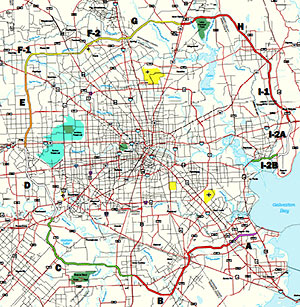 From Dug Begley’s report on next weekend’s dual openings of the North Line light-rail extension and the Hempstead-to-Katy Segment E of the Grand Parkway: “[Judge] Emmett frequently notes that about 500,000 people live within Loop 610, about 1.5 million live between Loop 610 and the Sam Houston Tollway and about 2 million live outside the tollway within Harris County. ‘We’re seeing a lot of people moving inside the Loop,’ Emmett said. ‘That growth is going on. But for every person moving in, about four people are locating outside the beltway. Nothing is going to change that growth pattern.” [Houston Chronicle ($); previously on Swamplot] Map: Grand Parkway Association
From Dug Begley’s report on next weekend’s dual openings of the North Line light-rail extension and the Hempstead-to-Katy Segment E of the Grand Parkway: “[Judge] Emmett frequently notes that about 500,000 people live within Loop 610, about 1.5 million live between Loop 610 and the Sam Houston Tollway and about 2 million live outside the tollway within Harris County. ‘We’re seeing a lot of people moving inside the Loop,’ Emmett said. ‘That growth is going on. But for every person moving in, about four people are locating outside the beltway. Nothing is going to change that growth pattern.” [Houston Chronicle ($); previously on Swamplot] Map: Grand Parkway Association

Putting Google’s Landsat Annual Time Lapse function to work, Texas architect Samuel Aston Williams has created animated .GIFs that give a satellite’s view of how certain cities — Shanghai, Atlanta, Lagos, etc. — have changed during the past 30 years. And here’s Houston.
- The Devastating Impact of 30 Years of Sprawl, As Seen From Space [Atlantic Cities]
Image: Samuel Aston Williams via Atlantic Cities

Next month, reports Real Estate Bisnow’s Catie Dixon, construction’s supposed to start on 3 more segments of the Grand Parkway: That’s why F1, F2, and G on the map here are colored in that cautionary yellow. And where G ends? Not coincidentally, adds Dixon, at that future intersection with U.S. 59, planned to be completed by 2015, the 1400-acre master-planned Valley Ranch is getting ready to sprawl out.
COMMENT OF THE DAY: LOOKING AT OUR SPREAD “It’s interesting when friends from back east visit, because they almost universally observe that Houston is ’empty’ (to quote directly). Given the amount of space in this city, the idea that we need to build things far from everything (and then build more roads to get people to them) is really kind of bizarre.” [John (another one), commenting on Comment of the Day: Heading for Points Greener]
COMMENT OF THE DAY: YES, A RING ROAD EVEN FURTHER OUT THAN THE GRAND PARKWAY “I hate to be the one to break the news, but the next outer loop beyond Grand Parkway is already being planned. If you look at the land plan for Cross Creek Ranch, there’s a big right of way built into the western portion of the development. It is right close to the proposed terminus of the Westpark Toll Road and roughly aligns with FM 2855 to the north and Spur 10 to the south. Some of the economic development corporations and chambers of commerce out there have even begun tracing its route on their planning maps.” [TheNiche, commenting on The Swamplot Award for Special Achievement in Sprawl: The Official 2011 Ballot]
MY SPIDEY SENSE SAYS LOOK OUT FOR DRIVE-THRUS IN ISSUE 3 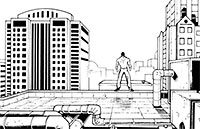 “They don’t get a ton of super-heroics or super-villainy down there, as far as we know. . . . As every comic book reading Houstonian on the Internet has pointed out, Houston doesn’t have as many skyscrapers as New York, so webslinging around is going to be a different experience. Kaine is going to deal with it in an amazing, unheard of way on occasion: by issue two, he’ll actually drive a car. He might have to hop on a bus, stick to the side of a truck—the possibilities are limitless. . . . It’s also really humid there. Sweating will be an issue. Grackles are a problem. Houston will offer some challenges, but it’s not like Godzilla lives there.” — Scarlet Spider writer Chris Yost, on setting the new comic featuring Spider-Man Peter Parker’s clone, Kaine, in Houston. [Marvel Comic News, via Hair Balls] Drawing: Marvel Comics
“They don’t get a ton of super-heroics or super-villainy down there, as far as we know. . . . As every comic book reading Houstonian on the Internet has pointed out, Houston doesn’t have as many skyscrapers as New York, so webslinging around is going to be a different experience. Kaine is going to deal with it in an amazing, unheard of way on occasion: by issue two, he’ll actually drive a car. He might have to hop on a bus, stick to the side of a truck—the possibilities are limitless. . . . It’s also really humid there. Sweating will be an issue. Grackles are a problem. Houston will offer some challenges, but it’s not like Godzilla lives there.” — Scarlet Spider writer Chris Yost, on setting the new comic featuring Spider-Man Peter Parker’s clone, Kaine, in Houston. [Marvel Comic News, via Hair Balls] Drawing: Marvel Comics

